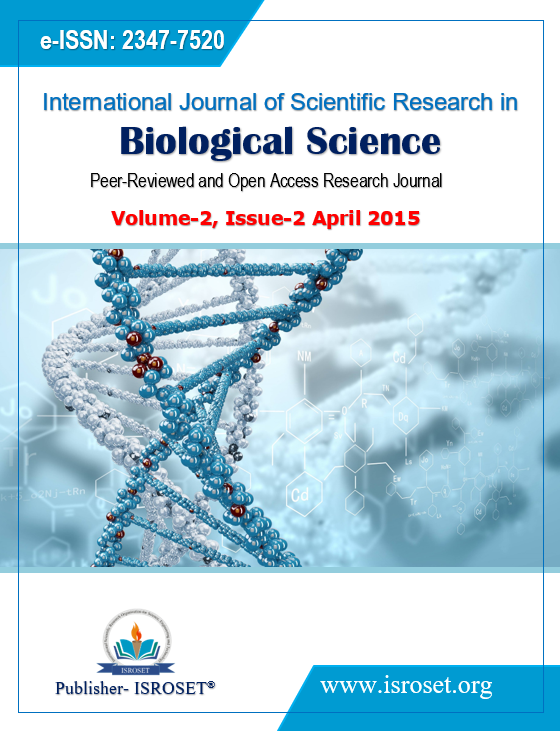Production, Purification and efficacy determination of Epsilon toxin from Clostridium perfringens type ‘D’ IVRI native culture
Keywords:
C.perfringens type ‘D’, Enterotoxaemia, Epsilon toxin, DEAE sepharose purification, Mouse toxicity testAbstract
Epsilon toxin of C.perfringens type ‘D’ IVRI native strain was produced by Batch type flask culture and further purified by using APS salt precipitation, Dialysis, DEAE sepharose separation and SDS PAGE analysis. It was also subjected to determine the toxicity by sing mouse toxicity test. Purified toxin showed the potent toxicity even at lowest dilution of 1:10,00,000 (toxin:Phosphate buffered saline).These findings suggested that purification increases the potency of toxin and thus lower the need of dose of vaccine administration which produced by the conversion of this toxin to toxoid. After purification a band of 32 kDA was obtained in SDS acrylamide gel autoradiograph showed the homogeneity with previously obtained results in this area of work. Epsilon toxin can penetrate the blood brain barrier so it could be prove as a potent vehicle for drug delivery system.
References
Farrell DH, Crosa JH. 1991. Purification and characterization of a secreted protease from the pathogenic marine bacterium Vibrio anguillarum. Biochemistry. Apr 9;30(14):3432-6.
Hughes M L, Poon R, Adams V, Sayeed S, Saputo J, Uzal F A, McClane B A,and Rood J I. 2007. Epsilon-Toxin Plasmids of Clostridium perfringens Type D Are Conjugative. J Bacteriol.; 189(21): 7531–7538.
IVRI Blue book. Production of anaerobic killed bacterial vaccines 2004.
Javed S, Rafeeq M M Tariq, Awan MA, Rashid N and Ali M. 2012. Study on in-vitro Biochemical Growth Characterization and Assessment of Hemolytic Toxin of Clostridium perfringens Type B and D. Pakistan J. Zool., vol. 44(6), pp. 1575-1580,.
McClain M S and Cover TL. 2007 Functional Analysis of Neutralizing Antibodies against Clostridium perfringens Epsilon-Toxin. Infect. Immun. vol. 75 no. 4 1785-1793
Miyamoto O, Minami J, Toyoshima T, Nakamura T, Masada T, Nagao S, Negi T, Itano T, and Okabe A. 1998. Neurotoxicity of Clostridium perfringens Epsilon-Toxin for the Rat Hippocampus via the Glutamatergic System. Infect Immun.; 66(6): 2501–2508.
Payne, D., and E. Oyston. 1997. The Clostridium perfringens ε-toxin, p. 439–447. In J. I. Rood, B. A. McClane, J. G. Songer, and R. W. Titball (ed.), The clostridia: molecular biology and pathogenesis. Academic Press, London, United Kingdom
Petit L, Gibert M, Gillet D, Laurent-Winter C, Boquet P, Popoff MR. 1997. Clostridium perfringens epsilon-toxin acts on MDCK cells by forming a large membrane complex. J Bacteriol. 179 (20):6480-7.
Rahaman M S, Akter M R, Abdullah M, Sayed Khan M A, Jahan M S, ZiaulHaque A.K.M., Lutful Kabir S.M.. 2013 Isolation, identification and characterization of Clostridium perfringens from lamb dysentery in Dinajpur district of Bangladesh.Scientific Journal of Microbiology. 2(4) 83-88
Shekarsaraei AG, Hasannia S, Pirooznia N, Ataiee F. 2014. The investigation of epsilon toxin effects on different cancerous cell lines and its synergism effect with methotrexate. J Cancer Res Ther.;10(1):15-20.
Sydney M. Finegold. 1996.Anaerobic Gram-Negative Bacilli. Medical Microbiology. 4th edition. University of Texas Medical Branch at Galveston;. ISBN-10: 0-9631172-1-1
Voidarou C, Bezirtzoglou E, Alexopoulos A, Plessas S, Stefanis C, Papadopoulos I, Vavias S, Stavropoulou E, Fotou K, Tzora A, Skoufos I. 2011. Occurrence of Clostridium perfringens from different cultivated soils. Anaerobe.; 17(6):320-4.
W. Turner and W. Rodwell The epsilon toxin of cl. Welchii type d mechanism of its development in cultures through the Action of extracellular proteinases upon e prototoxin.
Wells C L. and Wilkins T D. 1996. Clostridia: Sporeforming Anaerobic Bacilli. Samuel Baron,Medical
Downloads
Published
How to Cite
Issue
Section
License

This work is licensed under a Creative Commons Attribution 4.0 International License.
Authors contributing to this journal agree to publish their articles under the Creative Commons Attribution 4.0 International License, allowing third parties to share their work (copy, distribute, transmit) and to adapt it, under the condition that the authors are given credit and that in the event of reuse or distribution, the terms of this license are made clear.







